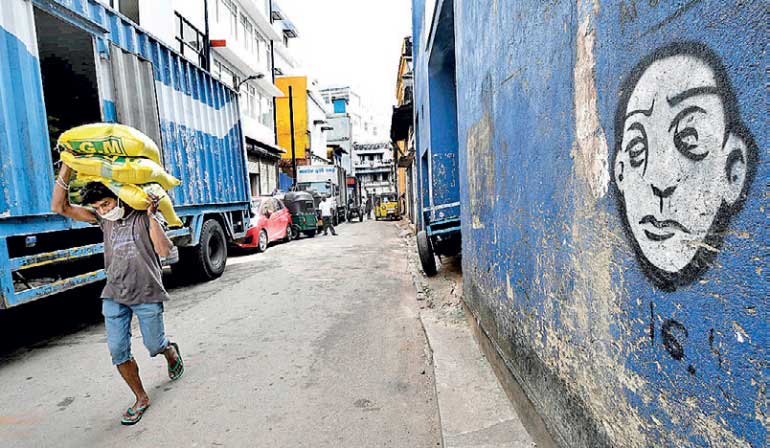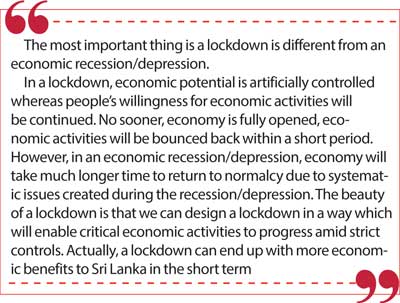Monday Dec 15, 2025
Monday Dec 15, 2025
Tuesday, 25 May 2021 00:00 - - {{hitsCtrl.values.hits}}

Daily wage workers earn Rs. 20,000 minimum per month. Lockdown means they do not have job opportunities – Pic by Shehan Gunasekara
By Charith Isuru
Will Sri Lanka’s economy collapse due to a lockdown? The answer is a big ‘no’!
What are possible scenarios that can cause a possible economic collapse in Sri Lanka during this COVID pandemic?
1. Substantial downturn in exports
2. Sizable loss in worker remittances
3. Unexpected surge in imports to an unbearable level.
4. Lack of foreign inflows to service country’s foreign debt
5. Hyper-inflation with almost no value of local currency
6. Loss of significant portion of work force due the virus
None of the above scenarios are possible due to a 30-day lockdown which is requested by health experts. (There are many other scenarios that can lead to economic depression during an ordinary time which the writer does not want to discuss in this article).
The Sri Lankan Government has carried out a successful operation in terms of controlling the COVID pandemic since inception in March 2020 with the help of the healthcare sector as well as Tri-forces and Police. Sri Lanka has been able to maintain a very low level of mortality rate compared to developed nations for the last 12 months. None of these achievements could have been possible without the proper guidance of the Government and efforts of the healthcare sector along with unconditional support of Tri forces and Police.
As citizens of Sri Lanka, we should be thankful to our healthcare sector as well as Tri forces/Police and Government leadership for containing the pandemic throughout the past 14 months. However, Sri Lanka has come to a trigger point in terms of active cases compared to its healthcare sector capacity which requires lightning-quick decision-making to contain the situation.
What are the possible implications of a lockdown?
Sri Lanka’s GDP in 2020 was approximately Rs. 15,000 billion and per day economic value addition was Rs. 41 billion. It means whole SL population average daily total income per day was Rs. 41 billion in 2020.
To elaborate further, Sri Lankans collectively earn Rs. 41 billion per day from economic activities.
On a simple note, one can say that if Sri Lanka goes for a lockdown, per day loss of income can be as high as Rs. 41 billion.
Good side of a lockdown 
The most important thing is a lockdown is different from an economic recession/depression.
In a lockdown, economic potential is artificially controlled whereas people’s willingness for economic activities will be continued. No sooner, economy is fully opened, economic activities will be bounced back within a short period. However, in an economic recession/depression, economy will take much longer time to return to normalcy due to systematic issues created during the recession/depression. The beauty of a lockdown is that we can design a lockdown in a way which will enable critical economic activities to progress amid strict controls. Actually, a lockdown can end up with more economic benefits to Sri Lanka in the short term.
For example: Per day crude oil consumption is approx. $ 10 million in Sri Lanka (assuming oil barrel is $ 60). If a lockdown is announced and 80% movement is controlled, crude oil consumption will at least be reduced to $ 5 million per day. Therefore, if Sri Lanka is locked down for 30 days, SL may save $ 150 million ($ 5 m* 30 days) worth of crude oil consumption cost per month.
Actually, if Sri Lanka can go for a lockdown with the exports sector open, Sri Lankan Rupee will be strengthened and pressure on exchange rate will be reduced. This was witnessed in 2020 with the help of the ban on non-essential imports.
On the other hand, a lockdown will put temporary breaks to economic activities which will lead to slower private sector credit growth and eventually result in a lower import cost to the economy during lockdown period.
Sri Lanka’s import Bill is approx. $ 50 million per day ($ 1,500 million per month on an ordinary year). As discussed above the country may save at least $ 5 million per day from lower crude oil consumption and if another $ 5 million worth of imports are saved due to lower private sector demand, as a country Sri Lanka can save up to $ 10 million per day by way of lower demand on imported items. Therefore, the country can save up to $ 300 million for a 30-day lockdown period ($ 10 m * 30 days).
The above scenario was witnessed in 2020 and exchange rate was stabilised around 185 level during the second half of 2020. (Ban on non-essential imports and mandatory credit on import settlement also helped the sentiment in 2020).
Lockdown in Sri Lanka has almost zero correlation with foreign worker remittances volumes. However, Sri Lanka should facilitate services relating to foreign employment with a view of increasing remittance volumes.
Further, the export sector has been allowed for business during the lockdown periods with the help of other essential services such as banking, ports, airfreight services, etc. Lockdown means less economic activities. Less economic activities mean lower consumption of both imported and locally produced resources. These will result in lower inflation and less pressure on exchange rate. Further, lower economic activities will lead to lower private sector credit demand and thereby ease pressure on interest rates.
Therefore, 30 days’ lockdown will help Sri Lanka to stabilise macroeconomic factors such as exchange rate, interest rate and inflation rate since supply side is protected as essential services (agriculture, estates, food production, exports, banking, etc. are protected and running as essential services during lockdowns).
All above economic benefits of a lockdown will be short-lived (maximum up to 1-3 months) and once the economy is fully-opened, imports will surge and credit growth will pick up as economic activities return to normalcy.
When the economy is fully-opened for business, Sri Lanka will face challenges in stabilising macroeconomic factors such as exchange rate due to zero foreign currency income from tourism.
This was witnessed in early 2021 where imports hit around $ 1,500 million per month, private sector credit growth was Rs. 218,000 million during Jan-Mar 2021 on the back of gradual easing of health restrictions relating to COVID-19. Moreover, surge in spending with the help of private sector credit caused more imports together with Government spending on infrastructure projects.
The writer believes that managing Sri Lanka’s economy during a lockdown is easy compared to managing macroeconomic factors without a lockdown with zero foreign currency income from tourism.
Disadvantage of a lockdown
The main disadvantage is negative economic growth. If a lockdown is imposed it will lead to less economic activities. Less economic activities will lead to loss of income to economic participants.
Main concern of the Government is daily wage workers in the country. Daily wage workers earn Rs. 20,000 minimum per month. Lockdown means they do not have job opportunities.
However, Sri Lanka has a rich culture where poor people are protected within the community during a disaster period. We saw it during aftermath of Tsunami/floods where people of this country did not allow any death due to hunger. Rich and able people helped the poor via various programs conducted through temple/church/kovil after each and every disaster.
Same strategy can be applied at this crucial moment where rich and able people in the community help the poor in the community. Nationwide programs can be implemented with the help of ‘religious leaders’ and media organisations.
On the other hand, Government can continue with its Rs. 5,000 monthly allowance targeting poor people. Government spent around Rs. 25-30 billion per month for Rs. 5,000 allowance. On the face of it, one may see spending Rs. 25-30 billion per month is a huge burden on Government. But as discussed in the previous section, Sri Lanka can save up to $ 300 million worth of much need foreign currency due to lack of demand during a lockdown. ($ 300 million is equal to Rs. 60 billion). Therefore, spending 25-30 billion on subsidies backed by $ 300 million saving on imports per month will not create any adverse economic impact to the economy. Moreover, providing Rs. 5,000 allowance to a person who earned Rs. 20,000 will not likely to create any inflationary pressure in the short term.
There is another disadvantage arising from a lockdown. Government tax income will be disturbed during a lockdown due to lack of economic activities. On a normal year Government collects more than Rs. 150 billion per month via taxes. This can reduce drastically during a lockdown where money printing will only be the alternative.
This is inevitable in a lockdown scenario. However, Government has the option to print money. Since ‘money multiplier’ impact is lower due to lack of economic activity during a lockdown period, Government money printing will not create any adverse inflationary pressures in the short term. However, Government will have to carefully manage inflation after the pandemic since money multiplier will be fully operative with printed cash. Spiral impact can be seen after one to two years.
As long as import restrictions are in place, Government money printing will not create unnecessary pressure on exchange rate. However, Government will have to be very careful when easing restrictions on imports after the pandemic since printed money within the system can create import demand. There are tools which can be used to manage macro-economic fundamentals after the pandemic which will enable Sri Lanka to put economy back on track.
Allowing economy to operate in full capacity with zero foreign income from tourism will create more issues than a lockdown scenario. This was evident during Q1 of 2021. Moreover, people of Sri Lanka request a nationwide lockdown from Government on the back of health experts’ comments. Opposition is also trying to gain advantage over pandemic spread/death numbers. According to health experts 28 days’ lockdown will be adequate to break the third wave cycle. For example: People survived during the two-and-half-month lockdown in 2020 and praised the Government for controlling the pandemic situation. Eventually, people voted in favour of the Government and gave two-third power to the President. Even people who lost their income sources due to pandemic lockdowns, generously voted in favour of Government in the Parliamentary Election because of the success showed in containing of the pandemic. Hence, controlling the COVID-19 pandemic will be key priority and expectation of people at this moment. If the Government can respond accordingly, it will be able to retain/regain its popularity.
Therefore, breaking the COVID-19 cycle via a 30-day nationwide lockdown, expediting vaccination program, tourism promotion after vaccination, and securing port city investments, will be critical success factors in bringing SL economy back to normalcy.
The writer believes that a 30-day nationwide lockdown can bring health benefits such as breaking of the third wave of the COVID-19 cycle, less stress on the healthcare system and economic benefits such as short-term macro-economic stability, and political benefits such as retain/regain of Government popularity.
Therefore, a nationwide lockdown is a win-win scenario for people as well as for the Government including the healthcare sector.
(The writer is in the finance profession and works as a Treasury Dealer. He could be reached via [email protected].)